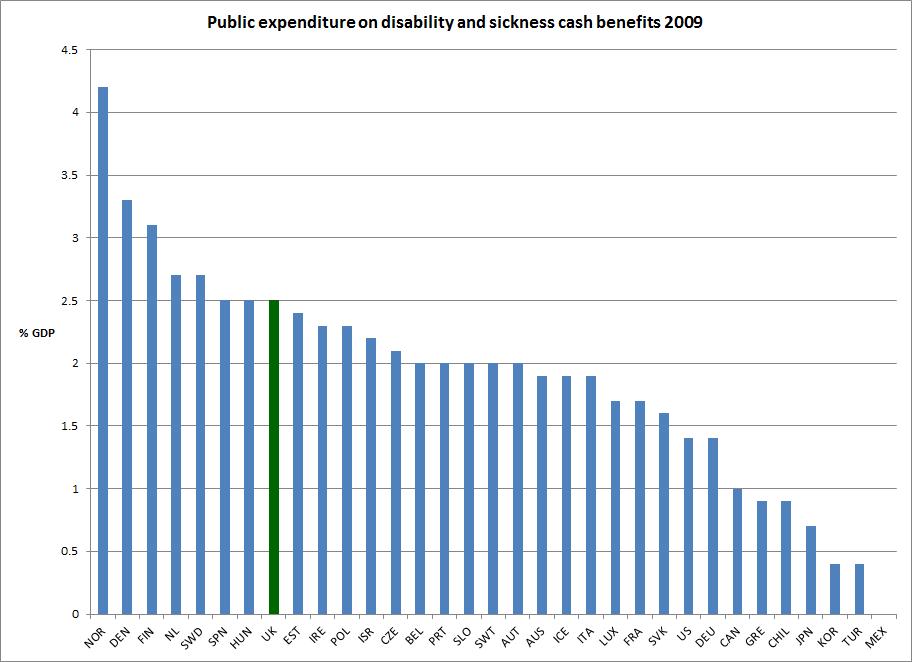A misuser's guide to the OECD social expenditure database

This is the opening section of a story in today's Daily Mail.
'Disability benefits are costing Britain more than almost any other western country.The revelation in a report by the Organisation for Economic Cooperation and Development will add fuel to the Government’s drive to cut back on the handout.The OECD figures show that Britain spends 2.4 per cent of national output on the benefit – more than France, Germany, Italy or Spain.
The share of GDP is more than double the 1 per cent in the US – and six times Japan’s 0.4 per cent.The average among the 34 OECD members – all industrialised states – is 1.3 per cent. Only Norway and Iceland spent more: 2.8 per cent.' http://www.dailymail.co.uk/news/article-2253509/Benefits-Britain-UK-lead... There's an almost identical story in the Express http://www.express.co.uk/posts/view/367046/How-Britain-nearly-tops-the-g...
There's something of a mystery about these stories as there is no new report or press release on disability benefits on the OECD website. The OECD has suggested (via Twitter) that the story may be sourced to an update of their Social Expenditure database (SOCX) from 12 November - I'm not sure about this as some of the figures being used correspond to that data but some don't. This all needs clarification (I've e-mailed the Mail journalist who wrote their story, but have had no response). But the important point is that many of the assertions in the passage I've cited from the Mail (and in the corresponding passages in the Express article) are demonstrably false, so I'd be surprised if these stories are an accurate reflection of the OECD's views. Moreover the figures cited seem to have been selected to create the impression that expenditure in the UK is exceptionally high while other figures which would not support this claim have been suppressed.
To explain: in order to produce comprehensive internationally comparable figures on expenditure the OECD uses a five-category classification of disability and sickness benefits. The Mail and Express stories use figures which seem to relate to one of these categories ('disability pensions') and ignore the others. The other categories relate to occupational injuries, paid sick leave and a catch-all 'other cash benefits' category. These categories account for very little public expenditure in the UK, but are important in many other countries, and therefore have to be included to provide accurate comparisons. Ideally comparisons should also take account of mandatory private insurance benefits as well as public expenditure but that's not central to the issues here.
The chart shows /public/ expenditure on all categories of disability and sickness benefits as a share of GDP for 2009, the latest year for which data is available through the Social Expenditure database. The data is here: http://stats.oecd.org/Index.aspx?datasetcode=SOCX_AGG 2.4% of GDP, the figure cited in today's tabloid stories, is the amount the UK spent on the first category in 2009. Adding the other categories makes virtually no difference to the UK figures (only 0.1%) but it makes a big difference to the international comparisons.
There is no league table of expenditure which the UK comes close to topping. Five (not two) OECD countries spend more than the UK and two spend the same amount, including Spain, contrary to the Mail's assertions. European countries are clustered in the range 2%-2.5%. The cross-national average public expenditure for the OECD countries is 1.9% of GDP, not the 1.3% reported by the Mail, and this average is pulled down by some exceptionally low expenditure countries - including Mexico, for which expenditure (as reported by the OECD) is zero. Low public expenditure in Germany and France is mainly due to the importance of mandatory private insurance in those countries' social security systems.
So the tabloid stories are essentially false, based on suppressing the data that doesn't fit with the absurd claim that Britain 'nearly tops the global benefits league' . I have no idea who was responsible for selecting the data in order to manufacture these stories - the fact that both the Mail and Express are citing the same figures indicates that there's a press release or background briefing note somewhere. Besides, does anyone think Mail or Express journalists worked out how to manipulate the data themselves?